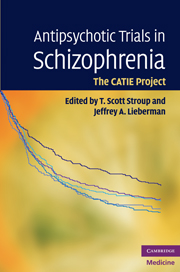22 results
Overview of late-onset psychoses
-
- Journal:
- International Psychogeriatrics / Volume 36 / Issue 1 / January 2024
- Published online by Cambridge University Press:
- 03 March 2023, pp. 28-42
-
- Article
- Export citation
Drug information update: paliperidone palmitate for schizophrenia
-
- Journal:
- The Psychiatrist / Volume 37 / Issue 5 / May 2013
- Published online by Cambridge University Press:
- 02 January 2018, pp. 164-166
- Print publication:
- May 2013
-
- Article
-
- You have access
- Open access
- HTML
- Export citation
Chapter 14 - Human subjects considerations
-
-
- Book:
- Antipsychotic Trials in Schizophrenia
- Published online:
- 03 May 2010
- Print publication:
- 01 April 2010, pp 255-266
-
- Chapter
- Export citation
Chapter 1 - Study design and protocol development process
-
-
- Book:
- Antipsychotic Trials in Schizophrenia
- Published online:
- 03 May 2010
- Print publication:
- 01 April 2010, pp 1-21
-
- Chapter
- Export citation

Antipsychotic Trials in Schizophrenia
- The CATIE Project
-
- Published online:
- 03 May 2010
- Print publication:
- 01 April 2010
Acknowledgments
-
- Book:
- Antipsychotic Trials in Schizophrenia
- Published online:
- 03 May 2010
- Print publication:
- 01 April 2010, pp xi-xii
-
- Chapter
- Export citation
Introduction
-
- Book:
- Antipsychotic Trials in Schizophrenia
- Published online:
- 03 May 2010
- Print publication:
- 01 April 2010, pp xiii-xviii
-
- Chapter
- Export citation
Chapter 16 - Implications for research design and study implementation
-
-
- Book:
- Antipsychotic Trials in Schizophrenia
- Published online:
- 03 May 2010
- Print publication:
- 01 April 2010, pp 281-287
-
- Chapter
- Export citation
Antipsychotic Trials in Schizophrenia - Half title page
-
- Book:
- Antipsychotic Trials in Schizophrenia
- Published online:
- 03 May 2010
- Print publication:
- 01 April 2010, pp i-ii
-
- Chapter
- Export citation
Copyright page
-
- Book:
- Antipsychotic Trials in Schizophrenia
- Published online:
- 03 May 2010
- Print publication:
- 01 April 2010, pp iv-iv
-
- Chapter
- Export citation
Contents
-
- Book:
- Antipsychotic Trials in Schizophrenia
- Published online:
- 03 May 2010
- Print publication:
- 01 April 2010, pp vii-viii
-
- Chapter
- Export citation
Dedication
-
- Book:
- Antipsychotic Trials in Schizophrenia
- Published online:
- 03 May 2010
- Print publication:
- 01 April 2010, pp v-vi
-
- Chapter
- Export citation
Chapter 3 - Effectiveness and efficacy: staying on treatment and symptom reduction
-
-
- Book:
- Antipsychotic Trials in Schizophrenia
- Published online:
- 03 May 2010
- Print publication:
- 01 April 2010, pp 39-56
-
- Chapter
- Export citation
Index
-
- Book:
- Antipsychotic Trials in Schizophrenia
- Published online:
- 03 May 2010
- Print publication:
- 01 April 2010, pp 307-312
-
- Chapter
- Export citation
Chapter 17 - Conclusion and implications for practice and policy
-
-
- Book:
- Antipsychotic Trials in Schizophrenia
- Published online:
- 03 May 2010
- Print publication:
- 01 April 2010, pp 288-306
-
- Chapter
- Export citation
Antipsychotic Trials in Schizophrenia - Title page
-
-
- Book:
- Antipsychotic Trials in Schizophrenia
- Published online:
- 03 May 2010
- Print publication:
- 01 April 2010, pp iii-iii
-
- Chapter
- Export citation
Contributors
-
-
- Book:
- Antipsychotic Trials in Schizophrenia
- Published online:
- 03 May 2010
- Print publication:
- 01 April 2010, pp ix-x
-
- Chapter
- Export citation
Extrapyramidal side-effects of antipsychotics in a randomised trial
-
- Journal:
- The British Journal of Psychiatry / Volume 193 / Issue 4 / October 2008
- Published online by Cambridge University Press:
- 02 January 2018, pp. 279-288
- Print publication:
- October 2008
-
- Article
-
- You have access
- HTML
- Export citation
Comparison of antipsychotic medication effects on reducing violence in people with schizophrenia
-
- Journal:
- The British Journal of Psychiatry / Volume 193 / Issue 1 / July 2008
- Published online by Cambridge University Press:
- 02 January 2018, pp. 37-43
- Print publication:
- July 2008
-
- Article
-
- You have access
- HTML
- Export citation
Determining when impairment constitutes incapacity for informed consent in schizophrenia research
-
- Journal:
- The British Journal of Psychiatry / Volume 191 / Issue 1 / July 2007
- Published online by Cambridge University Press:
- 02 January 2018, pp. 38-43
- Print publication:
- July 2007
-
- Article
-
- You have access
- HTML
- Export citation



